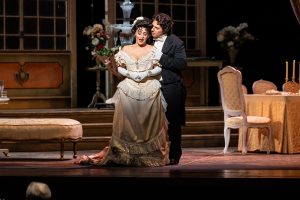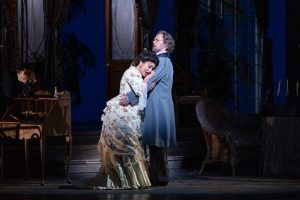
By Robert Croan
Verdi’s La Traviata, as staged for Florida Grand Opera by Chía Patiño [seen at the Broward Center, Nov. 30], contained many original and unusual touches while retaining the opera’s original 19th-century milieu.
Early on, in retelling Alexandre Dumas fils’ story of the courtesan who sacrifices her one chance of true love, the consumptive heroine — Violetta — suffers a spasm of coughing and sends her party guests to another room. The point is that her lover-to-be, Alfredo Germont, stays on so that they have a moment (and a hit-number duet) alone. Patiño brings on Violetta’s maid, Annina, an act sooner than the libretto calls for her, to assuage Violetta, and then make a visual commentary on the new liaison.
When the guests leave and Violetta has her grand solo scene that ends with the famous “Sempre libera,” Patiño has the Baron Duphol (Violetta’s current paramour, who normally would exit with the other guests) remaining behind to be serviced by her, while the words of her aria indicate that she’s thinking only about Alfredo. Credit must also go to Rick Fisher’s expert lighting designs, which clarified the director’s intent.
These are only two examples among the newly thought actions that set Patiño’s staging apart from the norm. Not all of them work. In the final act, for example, when the dying Violetta reads the letter from the elder Germont, her spoken voice morphs into that of the baritone who wrote the letter. That was effective in its way, but Violetta’s reading of the letter is a touchstone for the performer’s ability to encapsulate the expressive nuances, and the gimmick deprived the viewer of that detail.
There were no big-name stars, but a cast of capable young singers who functioned as a tightly knit theatrical ensemble. The challenges of singing Violetta begin with recreating a character made iconic by, among others, Greta Garbo in the 1936 film, Camille. Musically, it’s often said that she must be three sopranos in one: to negotiate the high and light coloratura meant to show her superficiality in Act 1, then the dramatic confrontation with the elder Germont — the great duet that is the very heart of this opera — and in the final act, when Alfredo returns to her (too late, of course), the lyrical poignance that propels the drama to its inevitable five-handkerchief conclusion.

Cecilia Violetta Lopez, a Mexican-American soprano from the small town of Rupert, Idaho, has the physical allure and stage savvy for the title role. She’s musically strong as well, with a focused lyric soprano sound that she can shade according to the words and sentiments. She was weakest in the first act, where her coloratura was shrill and not always pitch perfect, and an interpolated high E-flat at the end was forced. She came into her own thereafter, however, with a wide coloristic palette in the Act 2 duet. She began the crucial “Dite alla giovine” with an exquisite pianissimo, at first barely audible, gradually becoming an eruption of raw desolation.
She was matched in this scene and later on, by the plush, resonant baritone of Troy Cook, whose tone had less gradation but an admirable consistency from the top to bottom of the scale. His “Di Provenza” aria was a highlight for sheer tonal beauty and solid technique.
Pavel Petrov, the evening’s Alfredo, was not on their level. The Belarusian tenor has a pleasant, unforced sound and he enacted the lover with conviction and blended well with Lopez in their first- and last-act love duets. His delivery of the aria “De’ miei bollenti spiriti” was accurate but unremarkable, though he came through with a ringing high C to cap the subsequent cabaletta, “O mio rimorso” — a segment so difficult that it used to be omitted and has only recently (and justifiably) become de rigueur for this role.
The supporting roles in La Traviata, here assigned to the company’s studio artists, are essentially extensions of the chorus. Annina, however, has some significant lines of recitative (as well as a part in the melodic final quintet) and Sara Kennedy’s rich soprano sound bloomed in her brief solo turns. Keith Klein similarly impressed with resonant bass-baritone tones and a handsome presence as Dr. Grenville. The Baron has less to sing, but Joseph Canuto Leon came through as a decided presence.
Conductor Joe Illick was quite good keeping the orchestra in sync with the singers on stage — less so, in maintaining a balance of sound. Too often, instrumental details were lost as the orchestra faded into inaudibility — or conversely, when the brasses drowned out everything else. A weak link was Rosa Mercedes’ undernourished choreography, which made the opening part of Flora’s party (Act 2, Scene 2) seem endlessly long.